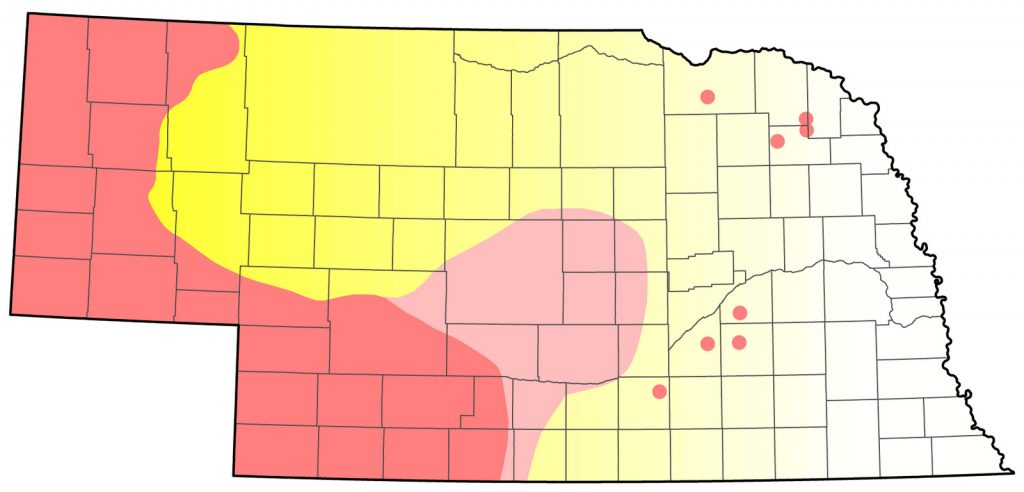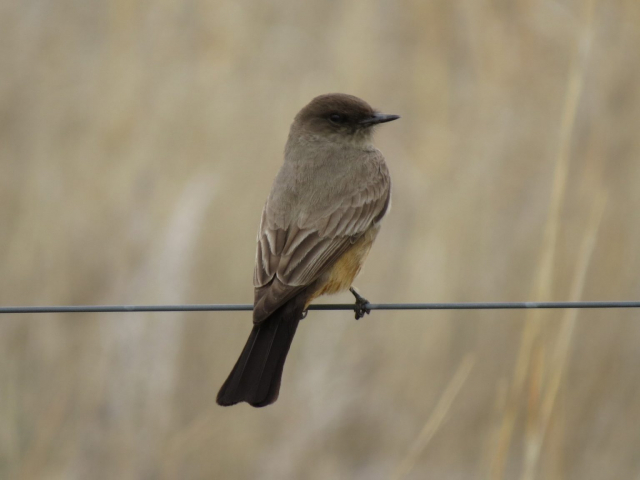Sayornis saya saya
Status: Common regular spring migrant west, fairly common central, uncommon northeast, rare southeast. Fairly common regular breeder west and southern west central, uncommon southern east central, rare casual east. Common regular fall migrant west, uncommon central, rare casual east.

Documentation: Specimen: UNSM ZM6369, 20 May 1900 Sioux Co.
Taxonomy: Two subspecies are recognized (AviList 2025), saya (including yukonensis and pallida) of Alaska, western Canada, western USA, to southern Mexico, and quiescens of Baja California, Mexico.
Schukman and Wolf (2020) synonymized saya and yukonensis, but retained pallida of Mexico as separate from saya.
Nebraska birds are saya (Rapp et al 1958).
Spring: Mar 23, 23, 24 <<<>>> summer (east of Panhandle); Apr 1, 3, 3 <<<>>> summer (Panhandle).
Earlier dates east of the Panhandle are 15 Mar 2024 Buffalo Co, 17 Mar 2018 Harlan Co, 18 Mar 2025 Buffalo Co, and 20 Mar 2017 Hall Co.
An early date in the Panhandle is 22 Mar 2024 Kimball Co.
Migrants occur east of the breeding range on occasion, rarely in the southeast; there are about 26 reports for the southeast 23 Mar-1 Jun.
- High counts: 18 in western Banner Co 4 May 1997, 11 in southern Kimball Co 8 May 1998, and 10 at Exit 1 on I-80, Kimball Co 10 Apr 2025.
Summer: Say’s Phoebe breeds commonly throughout the drier areas in the Panhandle and southwest, with lower numbers in the south and only sporadic breeding in the east. It is absent as a breeder from the western Sandhills and most of the east. The only known nesting attempt in Garden Co was unsuccessful at Crescent Lake NWR in 1980 (Williams 1980). McClure (1946) found that in central Nebraska in the early 1940s, there were 4.6 Say’s Phoebes per Eastern Phoebe, but during periods of population decline it has been limited essentially to the Panhandle. However, Shukman et al (2025) showed westward range expansion of Eastern Phoebe since the 1970s, displacing Say’s Phoebe in west central Kansas; this change was linked to westward shifts in vegetation preferred by Eastern Phoebe rather than Say’s Phoebe. There is some evidence that easterly nesting is sensitive to wet and dry 20-year climate cycles (Kent and Dinsmore 1996, Schukman and Wolf 2020), with easterly nesting in drier periods. It was “on the increase” in the Adams Co area in the 1920s (Jorgensen 2012) and common in central Nebraska in the early 1940s (McClure 1946); there were many summer records in the 1960s, even as far east as Cuming Co (Ducey 1988, Short 1961), and again in the 1980s and 2000s (see below).
Distribution in the northeast has fluctuated considerably historically, extending as far east as Cedar, Polk, and Cuming Cos and south to Adams and Hamilton Cos. Easternmost nesting records are from Dixon and Polk Cos. Mollhoff (2016) showed confirmed breeding during the period 2006-2011 in Cedar and Wayne Cos. At least one bird summered in southwest Dixon Co 1997-99, with sightings of single birds 28 Aug 2002, 9 Jul 2004, and 25 Aug 2011. In 2021, single birds were seen 6 Apr and 27 Jul at the same Dixon Co site; breeding may have occurred there. There are reports from Niobrara SP, Knox Co 12 Jun 2011, Niobrara Valley Preserve, Brown Co 15 Jun 2025, Cedar Co 27 Jun 2020, Boone Co (2) 13 Jul 2025, and Knox Co 18 Jul 2020 and 14 Jul 2025.
Jorgensen (2012) summarized its occurrence in the Rainwater Basin, citing numerous records from the 1920s through the 1980s. In 2019, an adult and a nest with young was found near Kissinger Basin WMA, Clay Co on 11 July; the adult was again observed on 24 July (Jorgensen and Brenner 2019). In Polk Co, Say’s Phoebes were present each year in the period 1984-89, including confirmed breeding in 1985 (Mollhoff 2001, Williams 1985), and there were reports from Hamilton Co in 1985 (Bennett 1986) and York Co in 1986 (Bennett 1987).
Currently, breeding is regular in the Platte River Valley east only as far as Phelps Co, where an immature which may have hatched locally was seen 26 Jun 1994, a single was there 6 Jul 1996 (Grzybowski 1996) and a territorial pair, along with possibly three additional birds, were sighted in southwest Phelps Co Apr-May 2003. Singles were reported at Sumner, Dawson Co 9 Jun 2013, Phelps Co 13 Jun 2008, and Buffalo Co 12 and 16 Jul 2023. Further east, a pair appeared to be nesting on a bridge in Howard Co 8 Jul 2016, a nest with eggs was at Fullerton, Nance Co 9 May 1955 (Wright and Wright; Mollhoff 2022), and a nest with eggs was at Alexandria, Thayer Co 4 Jun 1955 (Newell; Mollhoff 2022).
There are about 35 breeding season (Jun-Jul) reports in the area to the south and east of the western Sandhills bounded by Arnold, northeastern Lincoln Co; Taylor, southeastern Loup Co; Ericson, southwestern Wheeler Co; and Fullerton, Nance Co. The northernmost record of breeding in the north central is of a nesting pair at the edge of the breeding range in Broken Bow, Custer Co 4 Jul 2008. North of the above-described area, in the north central, there are 12 reports in the eastern Sandhills, and about eight reports east of the Sandhills including two sightings in 1982 in Brown and Cherry Cos (Brogie and Mossman 1983).
Despite fluctuating numbers and range, BBS trend analysis shows the species has increased annually by 1.23% (95% C.I.; -0.74, 3.13) during the period 1966-2019 (Sauer et al 2020).
- Breeding Phenology:
Nest Building: 20 Apr-5 May
Eggs: 10 May-24 Jul (commonly double-brooded; Mollhoff 2022)
Nestlings: 2 Jun-16 Jul
Fledglings: 21 Jun-4 Jul
A pair in Kimball Co had a second clutch of two eggs 29 Jun with five fledglings from the first clutch nearby, and a nest with 3-4 young in Hitchcock Co 16 Jul was probably a second clutch (Mollhoff 2008).
Fall: summer <<<>>> Oct 1, 2, 2
Later dates are 4 Oct 2004 Hayes Co, 4 Oct 2006 Sherman Co, 6 Oct 2019 Lancaster Co, 9 Oct 2013 Cherry Co, 11 Oct 2020 Garden Co, 17 Oct 2020 Thomas Co, and 21 Oct 2023 Douglas Co.
There are extraordinary late dates 14 Dec 2021 near Mitchell, Scotts Bluff Co, 27 Dec 2013 Keith Co (Stephen J. Dinsmore, personal communication), and at Smiley Canyon, Sioux Co 3 Jan 2022.
Departure is usually completed by late Sep; peak movement is late Aug-early Sep. An apparent post-breeding aggregation was the 15 along about two miles of 811 Road in Greeley Co 18 Aug 2023.
Say’s Phoebe is rare in fall away from the Panhandle and the central, with most of the few records from known breeding locations. In the east there are 19 fall reports in the period 2 Sep-9 Oct, but reports in the central are numerous (eBird.org, accessed Nov 2023).
- High counts: 10 at Exit 1 on I-80, Kimball Co, 9 there 27 Aug 2006, and 8 in Scotts Bluff Co 1 Sep 2001.
Images
Abbreviations
BBS: Breeding Bird Survey
NWR: National Wildlife Refuge
SP: State Park
UNSM: University of Nebraska State Museum
WMA: Wildlife Management Area (State)
Literature Cited
AviList Core Team, 2025. AviList: The Global Avian Checklist, v2025. https://doi.org/10.2173/avilist.v2025.
Bennett, E.V. 1986. 1985 Nebraska nesting survey. NBR 54: 31-35.
Bennett, E.V. 1987. 1986 Nebraska nesting survey. NBR 55: 31-35.
Brogie, M.A., and M.J. Mossman. 1983. Spring and summer birds of the Niobrara Valley Preserve, Nebraska: an annotated checklist. NBR 51: 44-51.
Ducey, J.E. 1988. Nebraska birds, breeding status and distribution. Simmons-Boardman Books, Omaha, Nebraska, USA.
Grzybowski, J.A. 1996. Southern Great Plains Region. Field Notes 50: 296-300.
Jorgensen, J.G. 2012. Birds of the Rainwater Basin, Nebraska. Nebraska Game and Parks Commission, Lincoln, Nebraska, USA.
Jorgensen, J.G., and S.J. Brenner. 2019. Notable avian nesting records from the Rainwater Basin, Nebraska — 2019. Nongame Bird Program of the Nebraska Game and Parks Commission, Lincoln, Nebraska, USA.
Kent, T.H., and J.J. Dinsmore. 1996. Birds in Iowa. Iowa City and Ames, IA: Kent and Dinsmore.
McClure, H.E. 1946. Phoebes in central Nebraska. Auk 63: 211-215.
Mollhoff, W.J. 2001. The Nebraska Breeding Bird Atlas 1984-1989. Nebraska Ornithologists’ Union Occasional Papers No. 7. Nebraska Game and Parks Commission, Lincoln, Nebraska, USA.
Mollhoff, W.J. 2008. The 2007 Nebraska nest report. NBR 76: 155-165.
Mollhoff, W.J. 2016. The Second Nebraska Breeding Bird Atlas. Bull. Univ. Nebraska State Museum Vol 29. University of Nebraska State Museum, Lincoln, Nebraska, USA.
Mollhoff, W.J. 2022. Nest records of Nebraska birds. Nebraska Ornithologists’ Union Occasional Paper Number 9.
Rapp, W.F. Jr., J.L.C. Rapp, H.E. Baumgarten, and R.A. Moser. 1958. Revised checklist of Nebraska birds. Occasional Papers 5, Nebraska Ornithologists’ Union, Crete, Nebraska, USA.
Sauer, J.R., W.A. Link, and J.E. Hines. 2020. The North American Breeding Bird Survey, Analysis Results 1966 – 2019: U.S. Geological Survey data release, https://doi.org/10.5066/P96A7675.
Schukman, J.M., P.J. Atauchi, and A.T. Peterson, 2025. Geographic shifts of phoebe species (Sayornis spp.) in the central Great Plains of North America. Wilson Journal of Ornithology. https://doi.org/10.1080/15594491.2024.2444021.
Schukman, J.M. and B.O. Wolf. 2020. Say’s Phoebe (Sayornis saya), version 1.0. In Birds of the World (P. G. Rodewald, Editor). Cornell Lab of Ornithology, Ithaca, NY, USA. https://doi.org/10.2173/bow.saypho.01.
Short, L.L., Jr. 1961. Notes on bird distribution in the central Plains. NBR 29: 2-22.
Williams, F. 1980. Southern Great Plains Region. American Birds 34: 286-288.
Williams, F. 1985. Southern Great Plains Region. American Birds 39: 319-322.
Recommended Citation
Silcock, W.R., and J.G. Jorgensen. 2025. Say’s Phoebe (Sayornis saya). In Birds of Nebraska — Online. www.BirdsofNebraska.org
Birds of Nebraska – Online
Updated 25 Aug 2025
![[envira-gallery id="14714"] [envira-gallery id="14714"]](https://birds.outdoornebraska.gov/wp-content/uploads/2018/05/Says-Pheobe-640x480.jpg)

